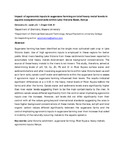Impact of agronomic inputs in sugarcane farming on total heavy metal levels in aquatic ecosystems and soils within Lake Victoria Basin, Kenya
Abstract
Sugarcane farming has been identified as the single most cultivated cash crop in Lake
Victoria basin. Use of high agronomic inputs is employed in these regions for better
yields. Most rivers feeding Lake Victoria from these catchments have been reported to
accumulate total heavy metals downstream above background concentrations. The
source of these heavy metals to the rivers is not known. This study, therefore, aimed at
determining levels of pH, Cd, Cu, Zn, Pb and Cr in River Kuywa surface water and
sediments before and after traversing sugarcane farms within Lake Victoria basin as well
as in farm soils, canals runoff water and sediments within the sugarcane farms to assess
if agronomic input in sugarcane farming influenced their levels. The results indicated
significant differences at p ≤ 0.05 in the heavy metal levels of River Kuywa before the
farms and after the farms. Canals water and sediments levels were significantly higher
than river water levels suggesting them to be the main contaminants to the river. In
addition canals values differed significantly from the control canal implicating agronomic
inputs over the increase. However, soil levels did not differ significantly from their
control with all the values going beyond international standards suggesting the area to
have higher background concentrations of these metals. None the less, soil pH and total
organic carbon values differed significantly between the sugarcane farms and the
control implicating agronomic inputs in sugarcane farming over their increase that aided
in mobility of the naturally occurring metals to the aquatic systems.

